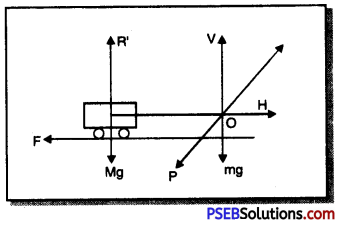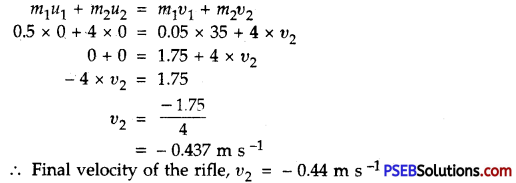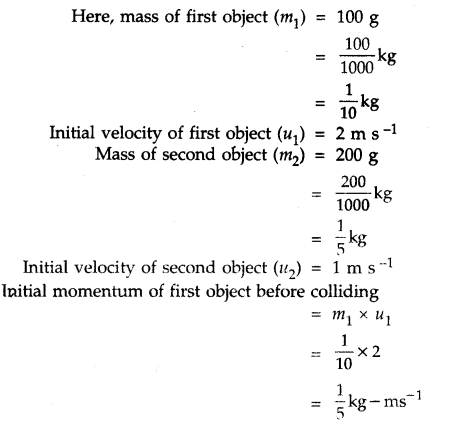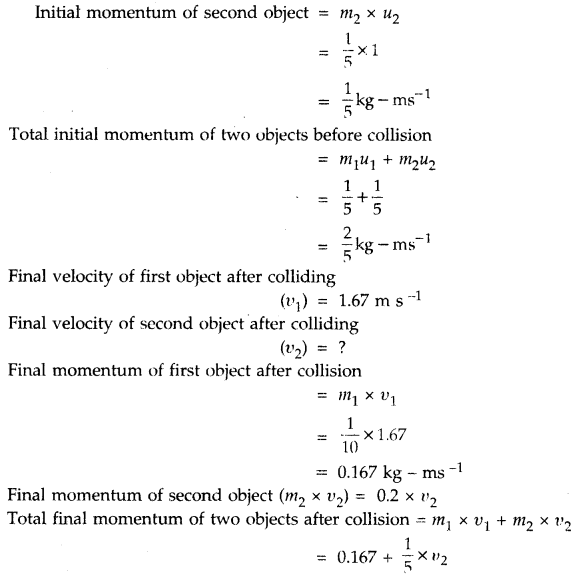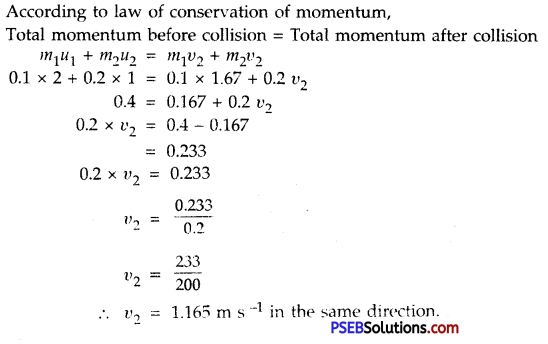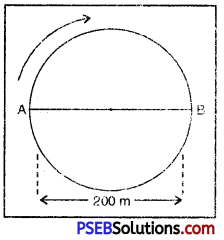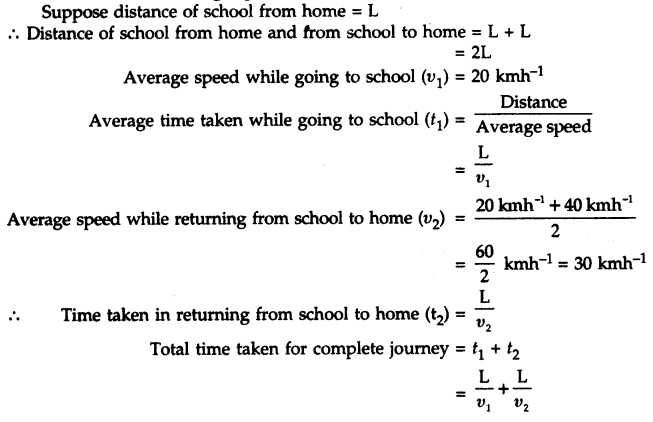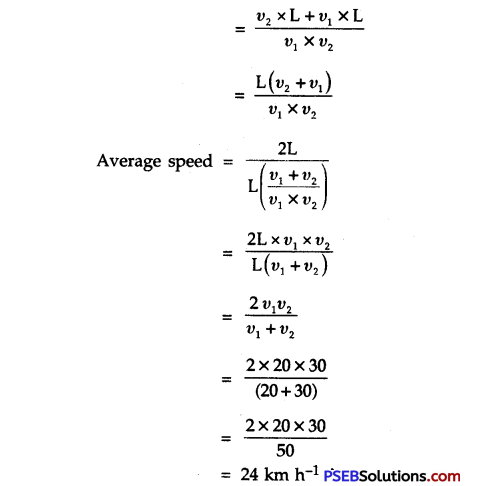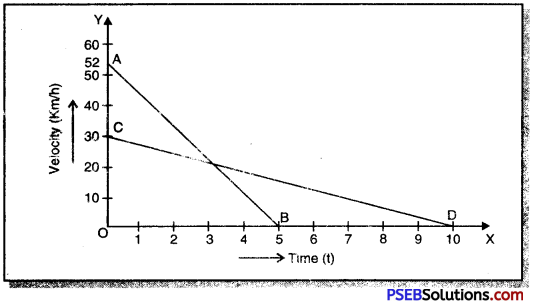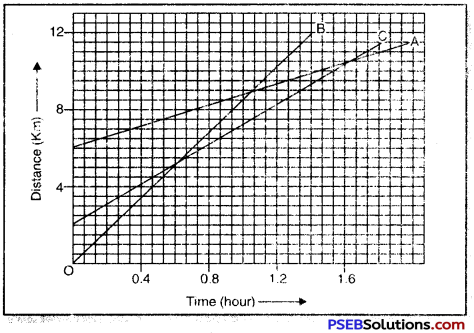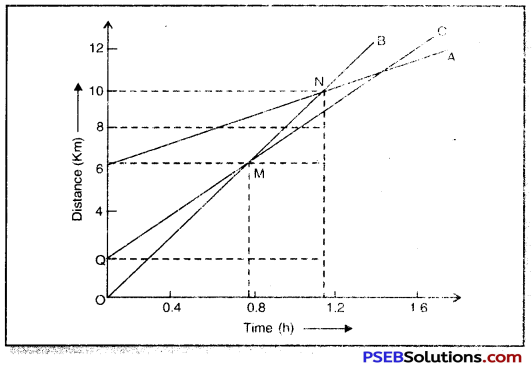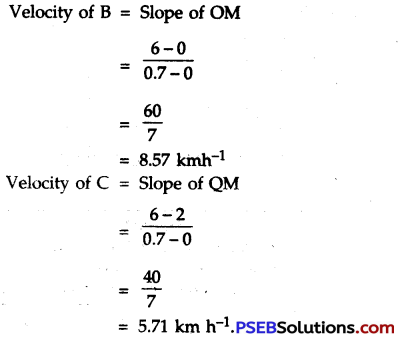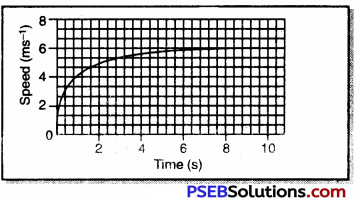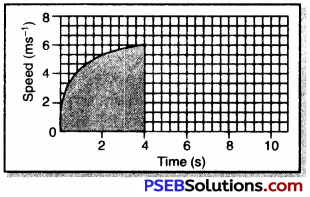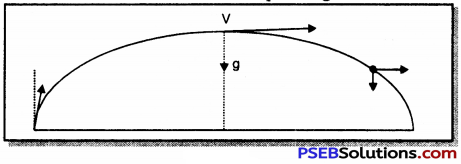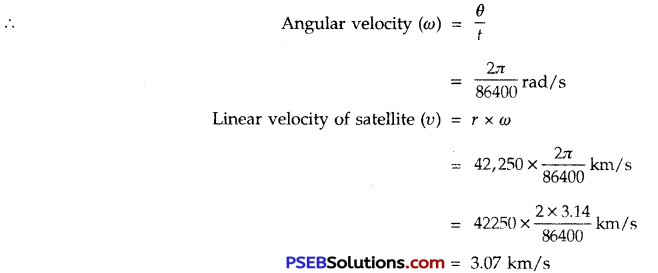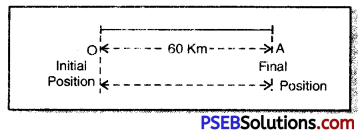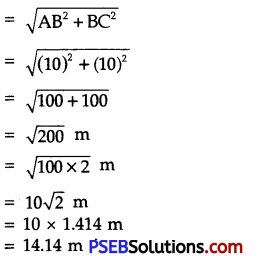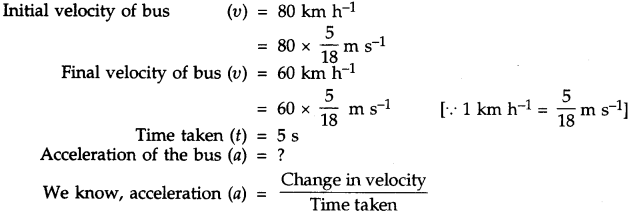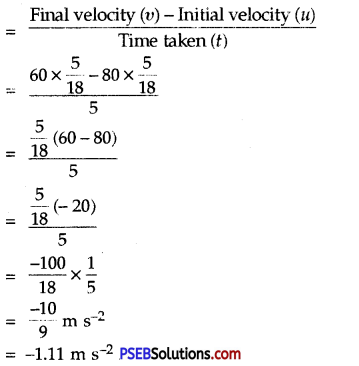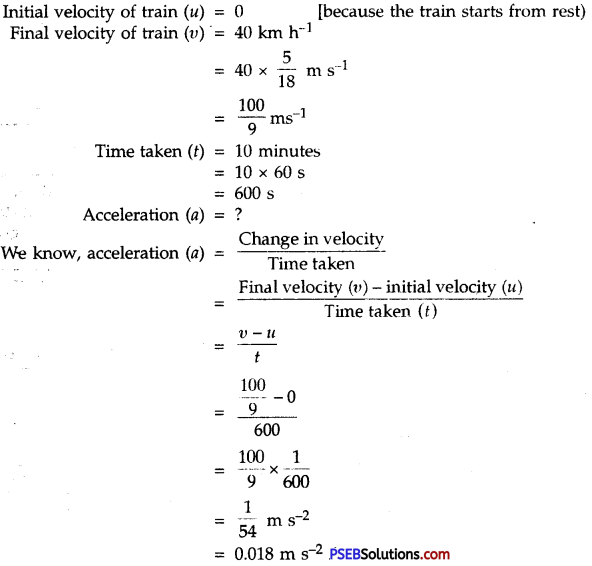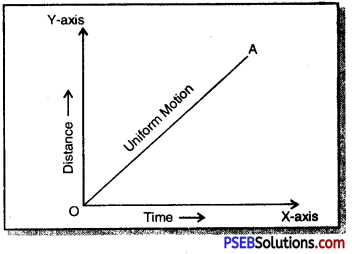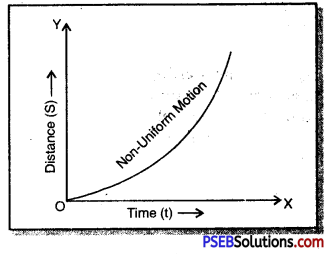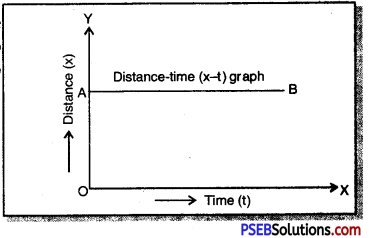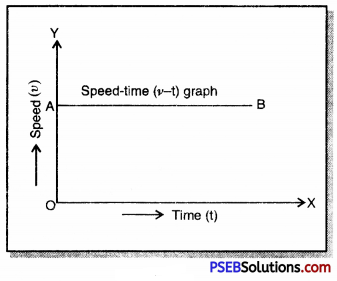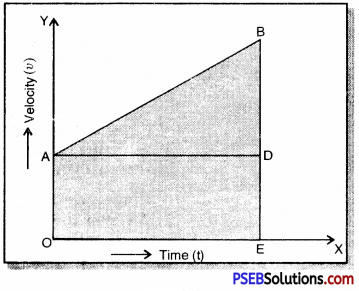Punjab State Board PSEB 9th Class Hindi Book Solutions Chapter 8 पाजेब Textbook Exercise Questions and Answers.
PSEB Solutions for Class 9 Hindi Chapter 8 पाजेब
Hindi Guide for Class 9 PSEB पाजेब Textbook Questions and Answers
(क) विषय-बोध
1. निम्नलिखित प्रश्नों के उत्तर एक-दो पंक्तियों में दीजिए
प्रश्न 1.
मुन्नी के लिए पाजेब कौन लाया?
उत्तर:
मुन्नी के लिए पाजेब उसकी बुआ लाई थी।
प्रश्न 2.
मुन्नी को पाजेब मिलने के बाद आशुतोष भी किस चीज़ के लिए ज़िद्द करने लगा?
उत्तर:
मुन्नी को पाजेब मिलने के बाद आशुतोष साइकिल के लिए ज़िद्द करने लगा।
प्रश्न 3.
लेखक की पत्नी को पाजेब चुराने का संदेह सबसे पहले किस पर हुआ?
उत्तर:
लेखक की पत्नी को पाजेब चुराने का संदेश सबसे पहले घर के नौकर बंशी पर हुआ।
![]()
प्रश्न 4.
आशुतोष को किस चीज़ का शौक था?
उत्तर:
आशुतोष को पतंग उड़ाने तथा साइकिल का शौक था।
प्रश्न 5.
वह शहीद की भाँति पिटता रहा था। रोया बिल्कुल नहीं था उपर्युक्त संदर्भ में बताइए कि कौन पिटता रहा?
उत्तर:
आशुतोष पिटता रहा।
प्रश्न 6.
गुम हुई पाजेब कहाँ से मिली?
उत्तर:
गुम हुई पाजेब बुआ के पास से मिली।
![]()
2. निम्नलिखित प्रश्नों के उत्तर तीन-चार पंक्तियों में दीजिए
प्रश्न 1.
लेखक को आशुतोष पर पाजेब चुराने का संदेह क्यों हुआ?
उत्तर:
लेखक को आशुतोष पर पाजेब चुराने का संदेह इसलिए हुआ क्योंकि उसे अपने नौकर बंशी पर पूर्ण विश्वास था कि वह पाजेब नहीं चुरा सकता। लेखक का शक तब यकीन में बदल गया जब उसे पता चला कि शाम को आशुतोष पतंग और डोर का पिन्ना लाया है।
प्रश्न 2.
पाजेब चुराने का संदेह किस-किस पर किया गया?
उत्तर:
पाजेब चुराने का सर्वप्रथम संदेह कथाकार की पत्नी ने घर के नौकर बंशी पर किया। इसके बाद संदेह आशुतोष पर किया गया। उसी से बातचीत में छुन्नू का नाम सामने आया और छुन्नू पर भी पाजेब की चोरी का शक किया गया।
प्रश्न 3.
आशुतोष ने चोरी नहीं की थी फिर भी उसने चोरी का अपराध स्वीकार किया। इसका क्या कारण हो सकता है ?
उत्तर:
आशुतोष ने चोरी नहीं की थी, यह बात पूर्ण रूप से सच है किंतु घर के सभी सदस्य पाजेब चुराने का शक उसी पर कर रहे थे। उसे कोठरी में भी बंद किया गया। माता-पिता दोनों उस पर क्रोधित थे। दोनों ही आशुतोष पर झल्ला रहे थे। बार-बार उससे एक ही सवाल पूछा जा रहा था कि पाजेब किसने ली है?बार-बार के प्रश्नों से बचने के लिए तथा घर में शांति स्थापित करने के लिए आशुतोष ने चोरी न करने पर भी पाजेब की चोरी का अपराध स्वीकार कर लिया होगा।
![]()
प्रश्न 4.
पाजेब कहाँ और कैसे मिली ?
उत्तर:
पाजेब आशुतोष की बुआ के पास मिली। जब आशुतोष की बुआ घर आई और उसने आशुतोष से कहा कि जो कागज़ात वह माँग रहे थे, वे सभी इसी बॉक्स में हैं। तभी उसने अपनी बॉस्केट की जेब में हाथ डालकर पाजेब निकाली और कहने लगी कि उस दिन भूल से यह पाजेब उसके साथ ही चली गई थी।
3. निम्नलिखित प्रश्नों के उत्तर छ:-सात पंक्तियों में दीजिए
प्रश्न 1.
आशुतोष का चरित्र-चित्रण कीजिए।
उत्तर:
कहानी में आशुतोष एक प्रमुख पात्र है। सारी कहानी उसी के चारों ओर घूमती है। वह एक बच्चा है। मुन्नी की जिद्द पूरी होने पर वह भी साइकिल लेने की जिद्द ठान लेता है। वह पाजेब पहनी हुई मुन्नी को बाहर घुमाने में गर्व महसूस करता है। चोरी का इल्ज़ाम आशुतोष पर लगने के कारण वह हठी और उदंड बन जाता है। वह झुठ भी बोलता है। उसमें अपना दोष दूसरों पर डालने का विकार भी है। उसका चरित्र पूर्णत: मनोविज्ञान से प्रभावित है।
प्रश्न 2.
आशुतोष के माता-पिता ने बिना किसी मनोवैज्ञानिक सूझबूझ के आशुतोष के प्रति जो व्यवहार कियाउसे अपने शब्दों में लिखिए।
उत्तर:
आशुतोष के माता-पिता ने उसके साथ बिल्कुल भी अच्छा व्यवहार नहीं किया था। उन्होंने तो यह तक भी सोचने का प्रयास नहीं किया कि बच्चों के साथ कैसे पेश आना चाहिए। सर्वप्रथम आशुतोष के पिता ने उस पर चोरी करने का शक किया। उसे डराया, धमकाया तथा उसके कान भी खींचे। आशुतोष की माँ ने भी उसे मारा-पीटा तथा धमकाया। आशुतोष के गाल भी सूज गये थे। वह पूरी तरह से डरा हुआ था। उसे कोठरी में बंद करके तो अत्याचार की सारी सीमाएँ ही लाँघ दी जाती हैं। अंत में जब बुआ उन्हें पाजेब देती है तो आशुतोष के पिता अपना सा मुँह लेकर रह जाते हैं। ये सब बातें दर्शाती हैं कि आशुतोष के माता-पिता ने बिना किसी मनोवैज्ञानिक सूझबूझ के आशुतोष के प्रति जो व्यवहार किया वह एकदम अनुचित था।
![]()
प्रश्न 3.
आशुतोष के किन कथनों और कार्यों से संकेत मिलता है कि. उसने पाजेब नहीं चुराई थी?
उत्तर:
आशुतोष के निम्नलिखित कथनों तथा कार्यों से संकेत मिलता है कि उसने पाजेब नहीं चुराई थी
1. जब आशुतोष के पिता ने उसकी माँ से पूछा था कि उसने आशुतोष से पूछा तो माँ ने कहा, ‘हाँ’, वो तो स्वयं उसकी ट्रंक और बॉक्स के नीचे घुस-घुसकर ढूंढ़ने में उसकी मदद कर रहा था।
2. पिता के कहने पर आशुतोष का कमरे के कोने-कोने में पाजेब को ढूँढ़ना।
3. छुन्नू के पास जाने से इन्कार करना।
4. यह कहना कि छुन्नू के पास होगी तो देखना।
5. किसी भी बात का हाँ और ना में ठीक से उत्तर न देना।
प्रश्न 4.
“प्रेम से अपराध वृत्ति को जीता जा सकता है, आतंक से उसे दबाना ठीक नहीं है ….” इस वाक्य का आशय स्पष्ट कीजिए।
उत्तर:
इस वाक्य का आशय है कि अपराधवृत्ति को दबाने के लिए दण्ड का सहारा उचित नहीं। दंड व्यक्ति को उदंड बनाने का काम करता है। उसमें जिद्दीपन तथा हट्ठीपन लाता है। इसके विपरीत प्यार व्यक्ति के भावों को समझने का काम करता है। प्यार से व्यक्ति दूसरे के दिल को पिघला कर मोम कर लेता है। उसके अंदर की बातों को जान लेता है तथा उसकी अपराध वृत्ति को अपने प्यार के कोमल हथियार से जीत लेता है।
![]()
(ख) भाषा-बोध
1. निम्नलिखित वाक्यों में उपयुक्त स्थान पर उचित विराम चिह्न का प्रयोग कीजिए
प्रश्न 1.
बुआ ने कहा छी-छी तू कोई लड़की है
उत्तर:
बुआ ने कहा, “छी-छी तू कोई लड़की है ?”
प्रश्न 2.
मैंने कहा छोड़िए भी बेबात की बात बढ़ाने से क्या फायदा
उत्तर:
मैंने कहा, “छोड़िए भी। बेबात की बात बढ़ाने से क्या फायदा!”
प्रश्न 3.
मैंने कहा क्यों रे तू शरारत से बाज नहीं आयेगा
उत्तर:
मैंने कहा, “क्यों रे, तू शरारत से बाज़ नहीं आयेगा ?”
![]()
2. निम्नलिखित मुहावरों के अर्थ समझकर इनका अपने वाक्यों में प्रयोग कीजिए
मुहावरा – अर्थ – वाकय
खुशी का ठिकाना न रहना – बहुत प्रसन्न होना – ………………..
टस से मस न होना – अपनी ज़िद्द पर अड़े रहना – ………………..
• चैन की सांस लेना – राहत महसूस करना – ……………..
• मुँह फुलाना – रूठ जाना, नाराज़ होना – ……………..
उत्तर:
आद्या को जब उसकी मनपसंद फ्रॉक मिल गई तो उसकी खुशी का ठिकाना न रहा।
• नरेश अपनी बात से तनिक-सा भी टस से मस नहीं हुआ।
• जब रेखा ने सब सच-सच बता दिया तो उसकी माँ ने चैन की सांस ली।
• अपने ऊपर चोरी का इल्ज़ाम लगने पर मोहन मुँह फुलाकर बैठ गया।
![]()
3. निम्नलिखित वाक्यों का हिन्दी में अनुवाद कीजिए
(i) मान गेट डे निभा टी वृभा उप्ली गप्टी ।
(ii) मॅच वरिट हिँउ पाठा ठी सापीर ।
(iii) ਉਸ ਦਿਨ ਭੁੱਲ ਨਾਲ ਇਹ ਇੱਕ ਪਜੇਬ ਮੇਰੇ ਨਾਲ ਚਲੀ ਗਈ ਸੀ ।
(iv) घतात हिर प्टॅिव ठहीं उतां टी पोप उली ।
उत्तर:
(i) संध्या होने पर बच्चों की बुआ चली गई।
(ii) सच कहने में घबराना नहीं चाहिए।
(iii) उस दिन भूल से यह एक पाजेब मेरे साथ गई थी।
(iv) बाज़ार में एक नई प्रकार की पाजेब चली है।
![]()
(ग) रचनात्मक अभिव्यक्ति
प्रश्न 1.
पाजेब कहानी के लेखक के स्थान पर यदि आप होते तो आशुतोष के साथ कैसा व्यवहार करते ?
उत्तर:
‘पाजेब’ कहानी के लेखक के स्थान पर यदि हम होते तो आशुतोष से बड़े प्यार से पेश आते। उसके साथ खेल-खेल में बात जानने की कोशिश करते। तरह-तरह की बातों में लगा कर उससे बात ही बात में मतलब की बात जान लेते। किसी भी प्रकार से उस पर हाथ नहीं उठाते। न ही उसे डाँटते, धमकाते तथा कोठरी में बंद करते। उसे बड़े ही प्यार और दुलार से समझाते तथा स्थिति को सही करने का प्रयास करते।
प्रश्न 2.
यदि कभी बिना किसी पुष्टि के आप पर चोरी का इल्ज़ाम लगा दिया जाए तो आपकी स्थिति कैसी होगी?
उत्तर:
यदि कभी बिना किसी पुष्टि के हम पर चोरी का इल्ज़ाम लगा दिया जाए तो हमारी स्थिति अत्यंत दयनीय होगी। हमारी यकायक नींद उड़ जाएगी। शरीर काँपने लगेगा। मन में तरह-तरह के विचार आने लगेंगे कि लोगों को पता चलेगा तो वह हमारे बारे में क्या सोचेंगे।
(घ) पाठेत्तर सक्रियता
1. बालमन से संबंधित खेल (जैनेंद्र कुमार), ईदगाह (प्रेमचंद) आदि कहानियों को पढ़िए।
2. ‘पाजेब’ कहानी को अध्यापक की सहायता से एकांकी के रूप में मंचित कीजिए।
3. कहानी को पढ़ने के पश्चात् आपको अपने माता-पिता से जुड़े कुछ प्रसंग याद आए होंगे-उन्हें डायरी में लिखिए।
4. मार, डाँट और भय से बच्चों को सुधारा जा सकता है-इस विषय पर कक्षा में वाद-विवाद कीजिए।
![]()
(ङ) ज्ञान-विस्तार
1. आना : पुरानी मुद्रा में आना’ (इकन्नी), दुअन्नी, चवन्नी आदि मुद्राएँ चलती थीं। पुरानी मुद्रा के अनुसार आना’ से अभिप्राय था एक रुपये का सोलहवाँ हिस्सा।
2. गिल्ली डंडा : गिल्ली डंडा पूरे भारत में काफ़ी प्रसिद्ध खेल है। इसे सामान्यत: एक बेलनाकार लकड़ी से खेला जाता है जिसकी लंबाई बेसबॉल या क्रिकेट के बल्ले के बराबर होती है। इसी की तरह की छोटी बेलनाकार लकड़ी को गिल्ली कहते हैं जो किनारों से थोड़ी नुकीली या घिसी हुई होती है।
खेल का उद्देश्य डंडे से गिल्ली को मारना है। गिल्ली को ज़मीन पर रखकर डंडे से किनारों पर मारते हैं जिससे गिल्ली हवा में उछलती है। विरोधी खिलाड़ी को गिल्ली को पकड़ना होता है। यदि वह इसमें सफल हो जाता है तो पहला खिलाड़ी आऊट हो जाता है। यदि वह गिल्ली को न पकड़ पाए तो उसे उस गिल्ली को पहले खिलाड़ी के डंडे पर मारना होता है। इस तरह खेल इसी क्रम में जारी रहता है।
PSEB 9th Class Hindi Guide पाजेब Important Questions and Answers
प्रश्न 1.
मुन्नी की माँ का चरित्र-चित्रण कीजिए।
उत्तर:
कहानी में मुन्नी की माँ का चरित्र एक सामान्य नारी के समान है। वह बिना किसी प्रमाण के घर के नौकर बंशी पर पाजेब चुराने का शक करती है। इसके बाद बिना सच्चाई को जाने परखे वह छुन्न की माँ से भी जा लड़ती है। वह अपने विवेक से काम न लेकर तनाव से काम लेती है। मुन्नी की माँ भी अन्य नारियों की भाँति आभूषणों को चाहने वाली है। वह मुन्नी की पाजेब पर मोहित होकर उसी तरह की पाजेब अपने पति से लाने को कहती है।
![]()
प्रश्न 2.
‘पाजेब’ कहानी क्या एक घटना है या और कुछ है?
उत्तर:
‘पाजेब’ कहानी एक घटना है, जो मनोविज्ञान पर आधारित है। यह घटना प्रधान होने के बाद भी अपनी सच्चाई से बड़ी ही मार्मिक बन पड़ी है। कहानी में बच्चों की अदालत में बड़ों को कसूरवार ठहराया गया है। कहानी. घर के बड़ों को संदेश देती है कि उन्हें अपने निर्णयों पर पुनर्विचार करने पर बाध्य होना पड़ेगा।
एक शब्द/एक पंक्ति में उत्तर दीजिए
प्रश्न 1.
‘पाजेब’ कहानी के लेखक कौन हैं?
उत्तर:
जैनेन्द्र कुमार।
प्रश्न 2.
मुन्नी ने बाबू जी से कैसी पाजेब लाने के लिए कहा?
उत्तर:
जैसी रूकमन और शीला पहनती है।
प्रश्न 3.
‘नौकर को शह जोर बना रखा है’ किसने किसे कहा?
उत्तर:
मुन्नी की मम्मी ने मुन्नी के पापा को।
प्रश्न 4.
“यह कुलच्छनी औलाद जाने कब मिटेगी”-किसने किसके लिए कहा?
उत्तर:
छुन्नू की माँ ने छुन्नू के लिए।
![]()
प्रश्न 5.
गुम हुई पाजेब किससे मिली?कैसे?
उत्तर:
बुआ से। वह धोखे से इसे अपने साथ ले गई थी।
हाँ-नहीं में उत्तर दीजिए
प्रश्न 6.
आशुतोष बंसी का भाई है।
उत्तर:
नहीं।
प्रश्न 7.
आशुतोष बाईसिकिल लेने की हठ करने लगा।
उत्तर:
हाँ।
सही-गलत में उत्तर दीजिए
प्रश्न 8.
इतवार को बुआ आई और पाजेब ले आई।
उत्तर:
सही।
प्रश्न 9.
प्रकाश छुन्नू के पिता हैं।
उत्तर:
गलत।
![]()
रिक्त स्थानों की पूर्ति करें-
प्रश्न 10.
आखिर …. .. पर ….. को ……. हुआ।
उत्तर:
आखिर समझाने पर जाने को तैयार हुआ।
प्रश्न 11.
पैसे उसने …….. करके ……… को कहे हैं।
उत्तर:
पैसे उसने थोड़े-थोड़े करके देने को कहे हैं।
बहुविकल्पी प्रश्नों में से सही विकल्प चुनकर उत्तर लिखें
प्रश्न 12.
मुन्नी की माँ ने पाजेब की चोरी का दोष किस पर लगाया?
(क) छुन्नू
(ख) बंसी
(ग) मन्नू
(घ) रघू।
उत्तर:
(ख) बंसी।
प्रश्न 13.
मुन्नी के पिता के लिए पाजेब से बढ़कर क्या है?
(क) प्रेम
(ख) विश्वास
(ग) शांति
(घ) चोर।
उत्तर:
(ग) शांति।
![]()
प्रश्न 14.
आशुतोष कितने वर्ष का है?
(क) चार
(ख) पाँच
(ग) सात
(घ) आठ।
उत्तर:
(घ) आठ।
प्रश्न 15.
बुआ आशुतोष के लिए क्या लाई थी
(क) केले और मिठाई
(ख) बाईसिकिल
(ग) चाकलेट
(घ) सेब और अंगूर।
उत्तर:
(क) केले और मिठाई।
कठिन शब्दों के अर्थ
निज = अपना। पाजेब = नुपूर, पायल। आलोचना = गुण-दोष विवेचन। इतवार = रविवार। टखना = पिंडली एवं एड़ी के बीच की दोनों ओर उभरी हड्डी। बलैया लेना = बलिहारी जाना। हर्ष = प्रसन्नता, बरस = वर्ष। प्रतीत = ज्ञात। सुघड़ = सुडौल, सुंदर। सुपुर्द = सौंपना। घडीभर = थोड़े समय के लिए। मनसूबा = इरादा। गुस्ताख़ी = अशिष्टता, उदंडता। टटोलना = ढूँढ़ना। शहजोर = बलवान। प्रतिकार = कार्य आदि को रोकने के लिए किया जाने वाला प्रयत्न। स्नेह = प्यार। फ़रिश्ता = देवदूत । मुरौव्वत = उदारता। इल्ज़ाम = दोष । रोष = क्रोध। प्रतिरोध = विरोध। औलाद = संतान। आतंक = डर। उद्यत = तैयार। प्रण = प्रतिज्ञा। भयावह = भयानक। रत्ती-रत्ती = थोड़ी-थोड़ी। लाचारी = विवशता।
![]()
पाजेब Summary
जैनेंद्र कुमार लेखक-परिचय
जीवन-परिचय:
श्री जैनेंद्र कुमार हिंदी-साहित्य के सुप्रसिद्ध कथाकार हैं। उनको मनोवैज्ञानिक कथाधारा का प्रवर्तक माना जाता है। इसके साथ-साथ वे एक श्रेष्ठ निबंधकार भी हैं। उनका जन्म सन् 1905 ई० को उत्तर प्रदेश के अलीगढ़ जिले के कौड़ियागंज नामक स्थान पर हुआ था। उनकी प्रारंभिक शिक्षा हस्तिनापुर के जैन गुरुकुल में हुई। उन्होंने वहीं पढ़ते हुए दसवीं की परीक्षा उत्तीर्ण की। तत्पश्चात् काशी हिंदू विश्वविद्यालय में उच्च शिक्षा हेतु प्रवेश लिया लेकिन गाँधी जी के असहयोग आंदोलन से प्रेरित होकर उन्होंने बीच में ही पढ़ाई छोड़ दी और वे गाँधी जी के साथ असहयोग आंदोलन में शामिल हो गए। वे गाँधी जी से अत्यधिक प्रभावित हुए। गाँधी जी के जीवन-दर्शन का प्रभाव उनकी रचनाओं में स्पष्ट दिखाई देता है। सन् 1984 ई० में उनको साहित्य-सेवा की भावना के कारण उन्हें उत्तर प्रदेश हिंदी संस्थान में भारत-भारती सम्मान से सुशोभित किया। उनको साहित्य अकादमी पुरस्कार भी प्राप्त हुआ। भारत सरकार ने उनकी साहित्यिक सेवाओं के कारण पद्मभूषण अलंकृत किया। सन् 1990 ई० में ये महान् साहित्य सेवी संसार से सदा के लिए विदा हो गए।
रचनाएँ:
जैनेंद्र कुमार जी एक कथाकार होने के साथ प्रमुख निबंधकार भी थे। उन्होंने उच्च कोटि के निबंधों की भी रचना की है। हिंदी कथा साहित्य को उन्होंने अपनी लेखनी से समृद्ध किया है। उनकी प्रमुख रचनाएँ निम्नलिखित हैं
उपन्यास:
परख, अनाम स्वामी, सुनीता, कल्याणी, त्यागपत्र, जयवर्द्धन, मुक्तिबोध, विवर्त। कहानी संग्रह-वातायन, एक रात, दो चिड़िया, फाँसी, नीलम देश की राज कन्या, पाजेब। निबंध संग्रह-जड़ की बात, पूर्वोदय, साहित्य का श्रेय और प्रेय, संस्मरण, इतस्ततः, प्रस्तुत प्रश्न, सोच विचार, समय और हम।
साहित्यिक विशेषताएँ:
हिंदी-कथा साहित्य में प्रेमचंद के पश्चात् जैनेंद्र जी प्रतिष्ठित कथाकार माने जाते हैं। उन्होंने अपने उपन्यासों का विषय भारतीय गाँवों की अपेक्षा नगरीय वातावरण को बनाया है। उन्होंने नगरीय जीवन की मनोवैज्ञानिक समस्याओं का चित्रण किया है। इनके परख, सुनीता, त्यागपत्र, कल्याणी में नारी-पुरुष के प्रेम की समस्या का मनोवैज्ञानिक धरातल पर अनूठा वर्णन किया है।
जैनेंद्र जी ने अपनी कहानियों में दार्शनिकता को अपनाया है। कथा-साहित्य में उन्होंने मानव-मन का विश्लेषण किया है। यद्यपि जैनेंद्र का दार्शनिक विवेचन मौलिक है लेकिन निजीपन के कारण पाठक में ऊब उत्पन्न नहीं करता। इनकी कहानियों में जीवन से जुड़ी विभिन्न समस्याओं का उल्लेख किया गया है। उन्होंने समाज, धर्म, राजनीति, अर्थनीति, दर्शन, संस्कृति, प्रेम आदि विषयों का प्रतिपादन किया है तथा सभी विषयों से संबंधित प्रश्नों को सुलझाने का प्रयास किया है।
जैनेंद्र जी का साहित्य गाँधीवादी चेतना से अत्यंत प्रभावित है जिसका सुष्ठु एवं सहज उपयोग उन्होंने अपने साहित्य में किया है। उन्होंने गाँधीवाद को हृदयगम करके सत्य, अहिंसा, आत्मसमर्पण आदि सिद्धांतों का अनूठा चित्रण किया है। इससे उनके कथा साहित्य में राष्ट्रीय चेतना का भाव भी मुखरित होता है। लेखक ने अपने समाज में फैली कुरीतियों, शोषण, अत्याचार, समस्याओं का डटकर विरोध किया है।
भाषा शैली:
जैनेंद्र जी एक मनोवैज्ञानिक कथाकार हैं। उनकी कहानियों की भाषा शैली अत्यंत सरल, सहज एवं भावानुकूल है। इनके निबंधों में भी सहज, सरल एवं स्वाभाविक भाषा शैली को अपनाया गया है। इनके साहित्य में संक्षिप्त कथानक संवाद, भावानुकूल भाषा शैली आदि विशेषताएँ सर्वत्र विद्यमान हैं।
![]()
पाजेब कहानी का सार
जैनेंद्र कुमार द्वारा रचित ‘पाजेब’ कहानी को मध्यवर्गीय परिवार की घटनाओं पर आधारित कहानियों में रखा जा सकता है। यह कहानी सन् 1944 में लिखी गई थी।
कहानीकार की दो संतानें थीं। एक लड़का और दूसरी लड़की थी। लड़का लड़की से आयु में बड़ा था। उसका नाम आशुतोष था। लड़की का नाम मुन्नी था और उस की आयु चार वर्ष थी।
बाज़ार में इस समय एक नए प्रकार की पाजेब चल पड़ी थी। पैरों में पहनने के बाद वह पाजेब बहुत ही अच्छी लगने लगती थी। उस पाजेब की खास बात यह थी कि उसकी कड़ियाँ आपस में लचक के साथ जुड़ी रहती थीं। वह जिस किसी के भी पाँव पड़ जाती थी, वहीं सुंदर लगने लगती थी। जैसे उसका अपना कोई व्यक्तित्व ही नहीं था। आस-पड़ोस में रहने वाली सभी छोटी बड़ी लड़कियाँ वह पाजेब पहने घूम रही थीं। पहले किसी एक ने पहनी, फिर उसे देख दूसरी ने, तीसरी ने इस प्रकार पाजेब को पहनने का चलन बढ़ गया। मुन्नी, जो कहानीकार की पुत्री थी। वह भी जिद्द करने लगी कि वह भी अपने पैरों में पाजेब पहनेगी। पिता ने पूछा कि कैसी पाजेब पहनेगी तो उसने कहा कि जैसी पाजेब रुक्मन और शीला पहनती हैं, वह वैसी ही पाजेब पहनना चाहती है।
पिता ने पाजेब लाने की हामी भर दी। कुछ देर तो मुन्नी पाजेब की बात भूलकर किसी काम में लग गई लेकिन बाद में फिर उसे पाजेब की याद आ गई। उसकी बुआ भी दोपहर बाद आ गई। मुन्नी ने पाजेब लाने का प्रस्ताव अपनी बुआ के सामने भी रखा। बुआ ने मुन्नी को मिठाई खिलाई और उसे गोद में उठाते हुए कहा कि वह रविवार को अवश्य ही उसके लिए पाजेब लाएगी। जब रविवार आया तो मुन्नी की बुआ उसके लिए पाजेब लेकर आई। देखने में पाजेब बहुत सुंदर थी। वह चाँदी की थी जिसमें दो-तीन लड़ियाँ-सी लिपटी हुई थीं। पाजेब पाकर मुन्नी की खुशी का ठिकाना न रहा। उसने यह पाजेब अपनी सहेलियों को भी दिखाई। मुन्नी का बड़ा भाई आशुतोष उसे पाजेब सहित दिखाने के लिए आस-पास ले गया। अब आशुतोष भी जिद्द करने लगा कि उसे भी साइकिल चाहिए। बुआ ने उसे समझाते हुए कहा कि उसके जन्म-दिन पर वह उसे साइकिल दिला देगी। सारा दिन बीत जाने के बाद शाम को पाजेब निकाल कर रख दी गई । पाजेब पर बारीक काम होने की वजह से वह महँगी भी थी-पाजेब की सुंदरता और बनावट को देखकर कथाकार की पत्नी का मन भी उस पाजेब को लेने का कर गया। रात को जब कथाकार अपनी मेज़ के पास बैठे थे, तब उनकी पत्नी ने उन्हें बताया कि मुन्नी की पाजेब नहीं मिल रही है। उन्होंने पाजेब जिस स्थान पर रखी थी, अब पाजेब वहाँ नहीं है। सारे घर में पाजेब की तलाशी का काम शुरू हो गया।
![]()
घर में एक नौकर था। उसका नाम बंशी था। पत्नी को घर के नौकर बंशी पर शक था कि उसने ही पाजेब चुराई होगी। पाजेब रखते समय वह वहाँ मौजूद था। कथाकार को नौकर पर तनिक भी शक नहीं था। जब उन्होंने अपने पुत्र आशुतोष के बारे में जाँच-पड़ताल की तो उन्हें पता चला कि वह शाम को पतंग और डोर का नया पिन्ना लाया है। कथाकार का शक उस पर गहराता जा रहा था। सुबह होते ही उन्होंने आशुतोष को अपने पास बुलाकर बड़े ही प्यार से पाजेब के बारे में पूछा। किंतु पाजेब को उठाने की बात आशुतोष ने कबूल नहीं की। उस समय कथाकार के मन में तरह-तरह के विचार घूमने लगे कि-अपरांध के प्रति करुणा ही होनी चाहिए। रोष का अधिकार नहीं। प्रेम से ही अपराध वृत्ति को जीता जा सकता है। आशुतोष किसी भी प्रकार से अपराध कबूल नहीं रहा था। उसने सिर हिलाते हुए क्रोध से अस्थिर और तेज आवाज़ में कहा कि उसने कोई पाजेब नहीं ली है। उस समय कथाकार को लगा कि उग्रता दोष का लक्षण है। आशुतोष को बहलाने का बहुत प्रयत्न किया गया अंत में उसके दोस्त छुन्नू का नाम भी चोरी की इस घटना में आ गया। आशुतोष ने हाँ में सिर हिला दिया। जब उससे पाजेब माँग लाने को कहा गया तब आशुतोष कहने लगा कि छुन्नू के पास यदि पाजेब नहीं हुई तो वह कहाँ से लाकर देगा।
बात बढ़ते-बढ़ते छुन्नू की माँ तक पहुँच गई। छुन्नू की माँ मानने को तैयार नहीं थी कि उसके लड़के ने पाजेब ली है। आशुतोष ने जिद्द बाँधते हुए कहा कि पाजेब छुन्नू ने ही ली है। इस पर छुन्नू की माँ ने उसे खूब पीटा। किंतु मामले का निपटारा नहीं हो सका। छुन्नू से सवाल जवाब करने पर उसने कहा कि पाजेब उसने आशुतोष के हाथ में देखी थी। उसने वह पाजेब पतंग वाले को दे दी है। __ झमेला इतना अधिक बढ़ गया था कि अगले दिन कथाकार समय पर अपने दफ़्तर भी नहीं पहुंच पाया था। जाते समय कथाकार अपनी पत्नी से कह गया था कि बच्चे को अधिक धमकाना नहीं। प्यार से काम लेना। धमकाने से बच्चे बिगड़ जाते हैं और हाथ कुछ नहीं लगता। शाम के समय जब कथाकार दफ्तर से वापस आया तो उसकी पत्नी ने उसे बताया कि आशुतोष ने सारी बात सच-सच बता दी है। ग्यारह आने में उसने पतंग वाले को पाजेब बेच दी है। पैसे उसने थोड़े-थोड़े करके देने को कहा है। उसने जो पाँच आने दिए वे छुन्नू के पास हैं। पता चलने के बाद छुन्नू से पैसे माँगने की बात होने लगी। लेकिन वह किसी भी प्रकार से पैसे माँगने को तैयार नहीं था। तब आशुतोष के पिता ने ज़ोर से उसके कान खींचें और अपने नौकर से कहा कि इसे ले जाकर कमरे में बंद कर दो। नौकर बंशी ने आशुतोष को कमरे में ले जाकर बंद कर दिया। कुछ देर बाद आशुतोष से पतंग वाले के बारे में पूछा गया और उसे चाचा और बंशी के साथ पतंग वालों के पास भेज दिया गया। पाजेब लेने से दोनों पतंग वालों ने पूरी तरह से नकार दिया। आशुतोष से दुबारा पूछताछ होने लगी। इसी बीच आशुतोष की बुआ भी आ गई। कुछ देर बातचीत करने के बाद, वह एक बक्से को सरकाते हुए बोली कि इनमें वह कागज़ है जो तुमने माँगे थे। तभी बुआ ने अपनी बॉस्केट की जेब में हाथ डालकर पाजेब निकाली और बोली कि दिन में भूल से यह पाजेब उसके साथ चली गई थी।


